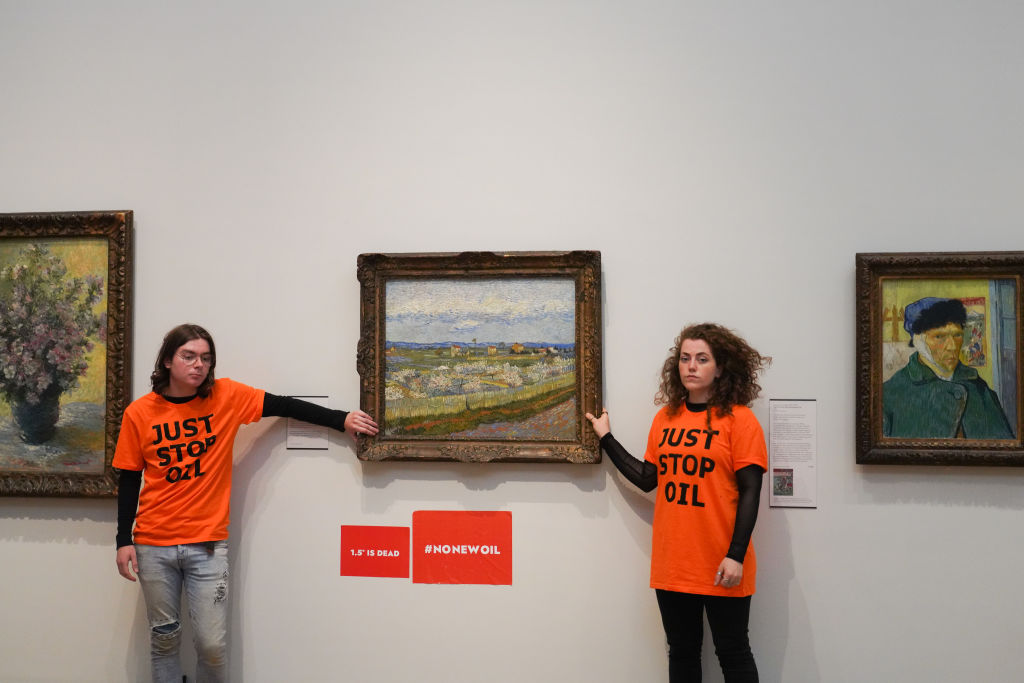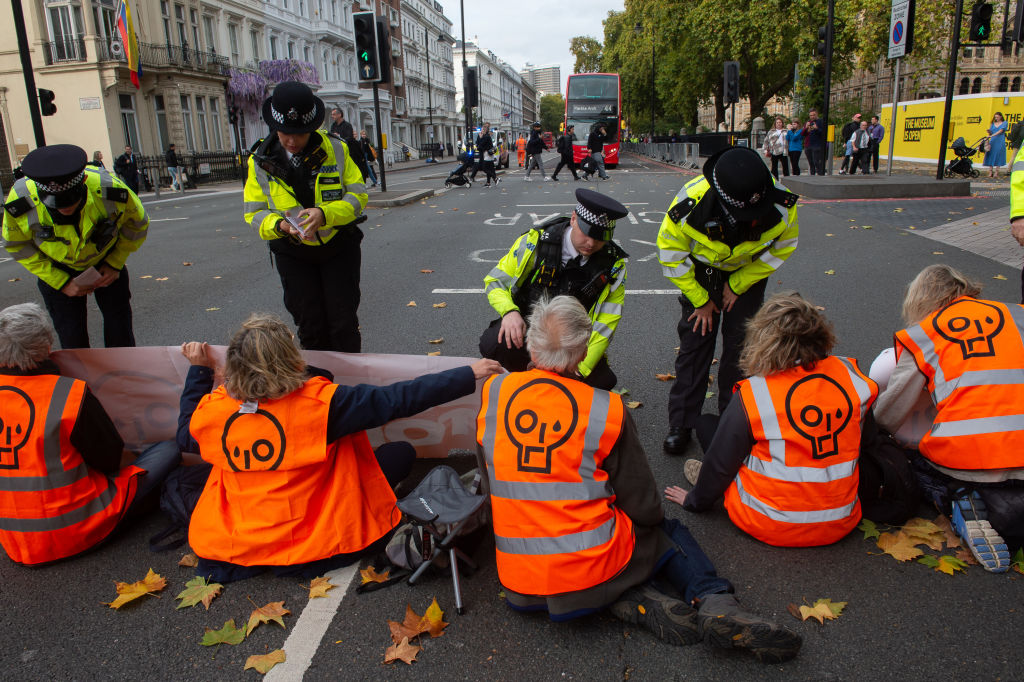Climate Protesters Are Throwing Soup at Art – The plan was to do something illegal, but no one among the two-dozen climate protesters assembled in a courtyard in Midtown Manhattan would tell me exactly what. Extinction Rebellion organizers were coming through the small crowd, asking who was “red role,” meaning that they were willing to be arrested. Someone else handed out cookies. Protesters soon started slipping off in twos and threes, heading to the site of the actual protest, part of a weeklong series of actions planned around the 10th anniversary of Hurricane Sandy in late October. Eric Arnum, an organizer from Extinction Rebellion NYC, remained behind; he told me they were acting as “decoys” to keep nearby police from following the other demonstrators. “They’re waiting for us to make our move, but we’ve already made our move,” he said, gesturing to a group of nearby police detectives.
“Put this in your article,” he added. “We play a giant game of cops and robbers with the best police force in the world, and we always win.”
Such acts of civil disobedience—long a part of environmental activism—surged in popularity toward the end of 2019 thanks to Greta Thunberg and the school strikes. That movement, especially powerful in the U.K., largely fizzled in early 2020 due to pandemic lockdowns. But now, the tactics of what climate activists call “civil resistance” are back, garnering more attention, and controversy, than ever. Some of those protests over the past year have targeted polluting industries—activists in the U.K., for instance, blocked access to oil terminals this spring, and this fall protesters in Germany glued themselves to the floor in a BMW showroom. Other actions have aimed to create maximum public disruption in the name of alerting people to the danger of climate change, as was seen with hellish traffic jams caused by months-long campaigns to block roadways in Germany and the U.K.
Another tactic has involved protesters targeting museum art pieces, often by attempting to glue themselves to the works—a strategy virtually guaranteed to generate widespread media attention. The trend in Europe exploded to international notoriety last month, when protesters threw tomato soup on one of the world’s most iconic paintings, Sunflowers by Vincent Van Gogh, in London’s National Portrait Gallery, before gluing their hands to the museum’s walls. Copycat protests quickly sprung up around Europe. In Germany, activists threw mashed potatoes over Grainstacks by Claude Monet, and in Italy, protesters threw pea soup on Van Gogh’s The Sower—none of the paintings, protected by glass, were damaged.

Just Stop Oil climate activists glue themselves to a Van Gogh painting at the Courtauld Gallery on June 30 2022 in London, U.K. The Just Stop Oil activists call for the government to end new oil and gas and for art institutions to join them in civil resistance.
No one person is directing these actions. The organizations involved, Germany’s Letzte Generation (Last Generation) and Britain’s Just Stop Oil, among others, operate independently from one another. But perhaps the closest thing to a global mastermind is a 36-year-old clinical psychologist named Margaret Klein Salamon, living in Brooklyn, NY. Salamon is the executive director of a group called The Climate Emergency Fund (CEF), which distributes money from wealthy donors to the climate movement’s radical vanguard around the world, including the activists I met in Manhattan.
Salamon says that CEF doesn’t actually fund anything illegal; its grants, generally ranging from $35,000 to $80,000, usually go to help new groups hire coordination staff. “There’s a lot of funders out there looking for how to make an impact on climate,” she says, walking her dogs in Prospect Park. “Even movements that utilize the passion and dedication of volunteers, they still need money.”
Many donors come from the ranks of the young and wealthy—inheritors getting access to trust funds for the first time—and Salamon sometimes takes them on walks like this to try to alleviate concerns around her groups’ activities. “Institutional philanthropy can get a little squeamish around direct action and disruptive protests,” she says. The pitch goes something like this: Society is sleepwalking into a climate catastrophe, a situation best explained by a famous social psychology experiment Salamon often references, in which a room slowly fills with smoke, but the participants don’t do anything about it, because no one else in the room seems alarmed. Disruptive protests are like a fire alarm to “shake us awake,” Salamon says. And refusing to play by the rules allows protesters to punch above their weight. Salamon, for instance, partially credits protesters who followed West Virginia Senator Joe Manchin to his car and protested on kayaks outside his houseboat last year for his ultimate decision to vote for the Inflation Reduction Act, the strongest climate legislation ever passed by Congress. The approximately $150,000 that CEF spent funding those groups, she says, provided a substantial return on investment. “My point is this approach gets results,” she says. “It’s not about liking their style, or even agreeing with everything that they do. It’s an understanding that this is absolutely needed. Playing by the rules, going step by step through normalcy, we’re walking off a cliff.”
Salamon has been touting some form of this argument for close to a decade. She co-founded a group called The Climate Mobilization in 2014 with the goal of launching what she called a “WWII-scale climate mobilization,” and was instrumental in seeding the term “climate emergency” into the 2016 Democratic Party platform. She helped lay out the initial vision for CEF in 2019 with oil heiress Aileen Getty. Getty co-founded the group with fellow donors Trevor Neilson, a renewable fuels entrepreneur, and Rory Kennedy, a filmmaker and a daughter of former U.S. Senator Robert Kennedy, before Salamon took over as executive director last year. She’s raised about $10 million since then—including $4 million from Don’t Look Up director Adam McCay this September—and distributed $4.5 million so far in 2022.
Notably, Salamon has never been arrested, unlike many members of the groups CEF funds or has helped to inspire. “I think I can help more from the office,” she says. Her behind-the-scenes work has been significant, though: Extinction Rebellion, founded in the U.K. in 2018, didn’t even have a “donate” button on its website before Salamon flew to London to help them get organized. Bill Beckler, who helped start New York’s chapter of Extinction Rebellion in 2018, became involved in climate organizing after a conversation with Salamon four years prior. He describes it as a profound, almost spiritual-level experience, a realization of the scale of impending climate catastrophe. “I just felt it in my bones,” he says, “I turned into a different person.”
Jeremy Strong, an actor known for his role as Kendall Roy on the HBO drama Succession, describes having a similar feeling after McCay, one of the show’s executive producers, introduced him to Salamon in June. “Meeting Margaret, one is reminded of the ending of Rilke’s poem, Archaic Torso of Apollo,” Strong says. “For here there is no place that does not see you. You must change your life.” Following that meeting, Strong says he was “effectively deputized by CEF.” “I have been actively fundraising and essentially proselytizing every chance I get while in the middle of filming Season 4 of Succession, on which I essentially own a climate change-denying news network,” he says.
Salamon’s advocacy is based on an understanding of climate change as an apocalyptic threat that can only be solved by a massive societal mobilization, which she refers to as “climate truth.” Accepting such a truth, she argues, leaves no room to live normally. “Your primary moral responsibility,” she writes in an essay titled The Transformative Power of Climate Truth, “is to fight for your family, your species and all life on Earth.” Much of society is living in denial, Salamon says, so it is the job of activists to convey that sense of alarm missing in media and politicians’ discussions of climate change. Those ideas and others, Beckler says, have “birthed” much of the radical climate movement: “There’s a lot of other people involved,” he says, “but these people are getting their influence from her.”
The Oct. 27 action in Manhattan, as it turned out, was targeting investment firm BlackRock—though I only figured that out after following the protesters to the company’s headquarters on 52nd Street, where they linked arms to block an escalator in a public atrium. One activist dumped a bag of coal on the floor, symbolic of the company’s investments in fossil fuels. “Hey BlackRock,” someone shouted through a megaphone, “burn this.” Dozens of police soon filed through the atrium’s revolving doors and, after a cursory message to disperse, began arresting the activists, tapping each on the shoulder to stand up before zip-tying their wrists while BlackRock analysts looked on from a second-floor balcony. After the last protester was led away, custodians moved in with brooms and dustpans. Within 20 minutes, all was as it had been: security guards back in their original places, business people chatting over cardboard takeout boxes. Someone began to play calming, cheerful music at a piano in the middle of the lobby.
Most climate protests have a relatively short shelf life in the public consciousness—if they get any media coverage at all. The Van Gogh protest was different—videos of the incident swiftly racked up millions of views, and sparked a firestorm of debate online. “I was not quite prepared for the level of [media attention], I mean it was so surreal,” says Phoebe Plummer, one of the participants. “We were sitting outside court, and we hadn’t had our phones, we hadn’t seen anything. And people started coming up and asking us for selfies.” Alice Hu, a climate activist with New York Communities for Change, which helped stage the BlackRock protest and is partly funded by CEF, says the whole movement started getting more attention in the days after the soup video went viral. “People are asking more thoughtful questions, and they’re thinking about this stuff critically,” she says.
“People become habituated to the soup, as it were, that they live in,” says Timothy Morton, an eco philosopher and literature professor at Rice University. “That’s the point of [the soup protest], to make everything suddenly uncanny…deliberately or not, to stop people and make them see things differently.”
But not all the attention has been positive. Online, it’s easy to find calls for Plummer and Anna Holland, the other soup thrower, to be imprisoned, or worse. Some observers have said that the actions risk making all climate activists look silly. British Foreign Secretary James Cleverly called the protesters “attention seeking adult-toddlers.” Salamon says the criticism is just as well—the most important thing is to increase the salience of climate change in the minds of voters and politicians. “It’s not a popularity contest,” she says. “The action has generated millions of conversations, so it’s beside the point.”
It’s unclear, though, whether it’s working. In the aftermath of the soup protests, Michael Mann, a prominent climate scientist, helped design a study in which researchers surveyed over 1,000 people, 46% of which said the protesters’ actions decreased their support for climate action. “They are alienating potential allies in the climate battle,” he wrote in TIME.
Even the activists themselves have admitted that not all attention-grabbing stunts are necessarily in the best interests of the movement, as in the case of an Oct. 2019 Extinction Rebellion action targeting the London Underground, where furious commuters dragged down and beat a protester who had climbed atop a subway carriage.
But in some way, that controversy goes deeper than execution. It has to do with the ideology animating these sorts of protests: that the way to protest climate inaction is not only to target polluters and fossil fuel lobbyists, but also a perceived complacency in the minds of millions of ordinary people. From that perspective, making people angry isn’t necessarily a side effect of the activists’ actions—it may be part of the point. “Of course social movements are unpopular,” Salamon says. “It’s a relatively small group of people telling a much larger group that they need to change.”










